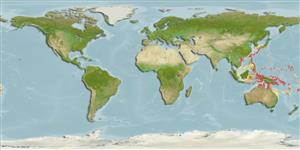Environment: milieu / climate zone / depth range / distribution range
Ecology
Marine; reef-associated; depth range 10 - 25 m (Ref. 90102). Subtropical
Western Pacific: Japan, Guam, New Guinea, and the Great Barrier Reef.
Size / Weight / Age
Maturity: Lm ? range ? - ? cm
Max length : 7.5 cm SL male/unsexed; (Ref. 48637)
Short description
Identification keys | Morphology | Morphometrics
Dorsal spines (total): 6 - 7; Dorsal soft rays (total): 12; Anal spines: 1; Anal soft rays: 12. Characterized by pale grey to whitish body color; several large brown spots on middle of side; back and side interspersed with brown mottling; posterior margin of first dorsal fin with pair of pale-edged black spots; united pelvic fins, well developed frenum present; longitudinal scale series 54-58; posterior body with ctenoid scales, becoming cycloid anteriorly; head without scales; greatest depth of body 5.5-6.4 in SL; lanceolate caudal fin, a little longer than head length; reduced posterior oculoscapular sensory canal, single pore (H') present (Ref. 90102).
Inhabits fine carbonate sand bottoms of well-protected lagoons (Ref. 37816). Found in coastal bays and estuaries on sand or muddy substrates to 25 meters depth (Ref. 48637). Also found in lagoons and sheltered bays in 10-25 m (Ref 90102).
Life cycle and mating behavior
Maturity | Reproduction | Spawning | Eggs | Fecundity | Larvae
Masuda, H., K. Amaoka, C. Araga, T. Uyeno and T. Yoshino, 1984. The fishes of the Japanese Archipelago. Vol. 1. Tokai University Press, Tokyo, Japan. 437 p. (text). (Ref. 559)
IUCN Red List Status (Ref. 130435: Version 2024-1)
Threat to humans
Harmless
Human uses
Tools
Special reports
Download XML
Internet sources
Estimates based on models
Preferred temperature (Ref.
123201): 25.2 - 29.3, mean 28.6 °C (based on 1198 cells).
Phylogenetic diversity index (Ref.
82804): PD
50 = 0.5000 [Uniqueness, from 0.5 = low to 2.0 = high].
Bayesian length-weight: a=0.00724 (0.00339 - 0.01546), b=3.10 (2.92 - 3.28), in cm total length, based on LWR estimates for this (Sub)family-body shape (Ref.
93245).
Trophic level (Ref.
69278): 3.3 ±0.4 se; based on size and trophs of closest relatives
Resilience (Ref.
120179): High, minimum population doubling time less than 15 months (Preliminary K or Fecundity.).
Fishing Vulnerability (Ref.
59153): Low vulnerability (10 of 100).
